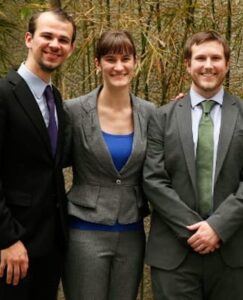
A team representing the University of Maryland won the $50,000 grand prize in the 2015 ULI Hines Competition for graduate students with its comprehensive design and development program for neighborhoods in downtown New Orleans.
The ULI Hines Competition—now in its 13th year—is part of the Institute’s ongoing effort to raise interest among young people in creating better communities, improving development patterns, and increasing awareness of the need for multidisciplinary solutions to development and design challenges.
The 2015 competition challenged multidisciplinary teams of graduate students to propose ideas to transform parts of the Tulane/Gravier and Iberville neighborhoods into a thriving urban neighborhood that takes advantage of its location, including its proximity to the French Quarter, adjacency to a medical district, and interaction with the Lafitte Greenway. The competition is designed as an exercise; there is no intention that the students’ plans will be implemented as part of any revitalization of the site.
The team from the University of Maryland edged out two teams from Harvard University and a joint team representing the University of Wisconsin – Milwaukee, and University of Wisconsin – Madison.
As the winning team, the University of Maryland students received $50,000; each of the remaining three finalist teams received $10,000. The announcement was made at the competition’s conclusion on April 9 in New Orleans. The 2015 victory for Maryland marks the second consecutive year that the university has won the Hines competition.
The winning master plan proposal—titled “The Crossing”—fosters sensitive growth by engaging the nearby medical campuses and the greenway. It develops a high-quality main street on Derbigny and phases in diverse housing stock at an appropriate urban scale. In the master plan, new development supports active programing under I-10, ensures affordable housing, and improves the area’s storm water infrastructure. Final phases of the plan reinforce the community-oriented approach. A proposed bus rapid transit works to improve accessibility for historically disadvantaged communities along North Claiborne Avenue. The ramp relocation and subsequent redesign of Basin Street unify the Lafitte Greenway and Louis Armstrong Park. Within the newly continuous green space, the Resilience Center symbolizes the essence of the proposal by bringing natives and visitors together to create an improved future for the city and its residents.
The other finalist teams and development schemes included:
- Harvard University: “Claiborne Grove” recalls the rich landscape that once characterized North Claiborne Avenue. The proposal bridges the existing potential of the site with the positive momentum of the surrounding communities to create an energetic new residential and cultural center for all age groups.
- Harvard University: The project “Tremé 2.0” project continues the Tremé neighborhood’s tradition of being the city’s trendsetter by reintroducing three new lifestyles in three themed corridors, woven together by a multilayered walkway system that allows visitors to engage in a modern interpretation of the traditional Vieux Carré courtyards and balconies.
- University of Wisconsin – Milwaukee, and University of Wisconsin – Madison: “Quartier Vert” weaves together culturally rich neighborhoods, a substantial health care project, and a prevalent tourism industry through a vibrant, sustainable, neighborhood-based New Orleans development.
The competition jury consisted of renowned experts from diverse backgrounds in real estate development. Jurors represent a strategic mix of land use experts, including developers, brokers, architects, urban designers, landscape architects, urban planners, and policy officials. In addition to Jury Chairman Pitchford, other jury members are: Tara Carter Hernandez, president, JCH Development, New Orleans, Louisiana; Dennis Dornan, senior associate and studio director, Perkins+Will, San Francisco, California; Kyrus L. Freeman, partner, Holland & Knight, Washington, D.C.; Jeff Hebert, executive director, New Orleans Redevelopment Authority, New Orleans, Louisiana; Matthew Hopkins, director of architecture and sustainability, StreetSense, Bethesda, Maryland; Michael Horst, consultant, New York, New York; Stephen G. Leeper, president and chief executive officer, 3CDC, Cincinnati, Ohio; Maureen McAvey, senior fellow and Bucksbaum Family chair for retail, ULI, Washington, D.C.; Kathryn L. Reynolds, founder and chief executive officer, Vivelan Group, New Orleans, Louisiana; Halina Steiner, creative director, dlandstudio, Brooklyn, New York; and Byron Stigge, director, Level Infrastructure, New York, New York.
Established with a generous endowment from longtime ULI leader Gerald D. Hines, the competition strives to encourage cooperation and teamwork—necessary talents in the planning, design and development of sustainable communities—among future land use professionals and allied professions, such as architecture, landscape architecture, urban planning, historic preservation, engineering, real estate development, finance, psychology and law.


